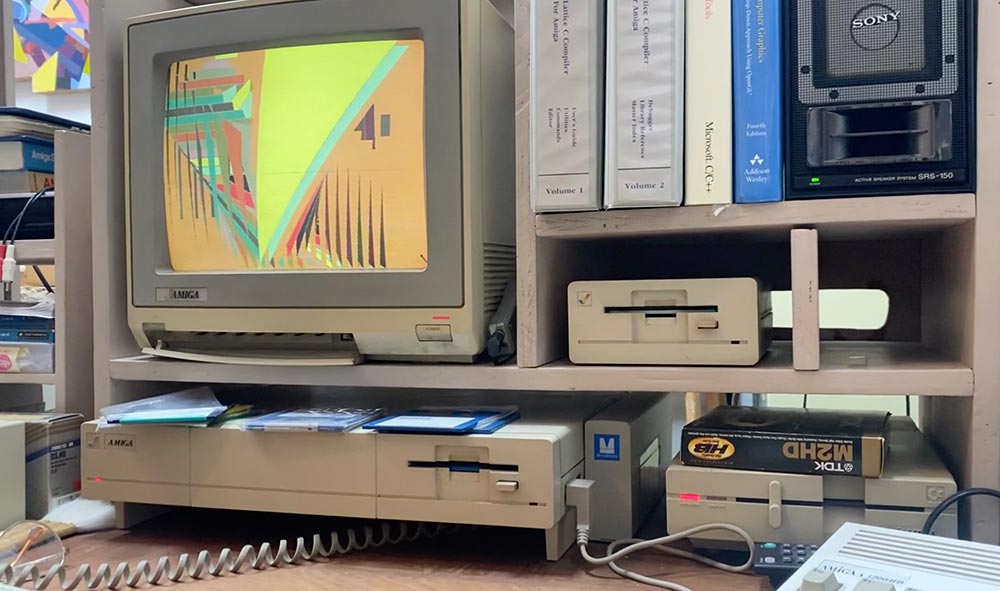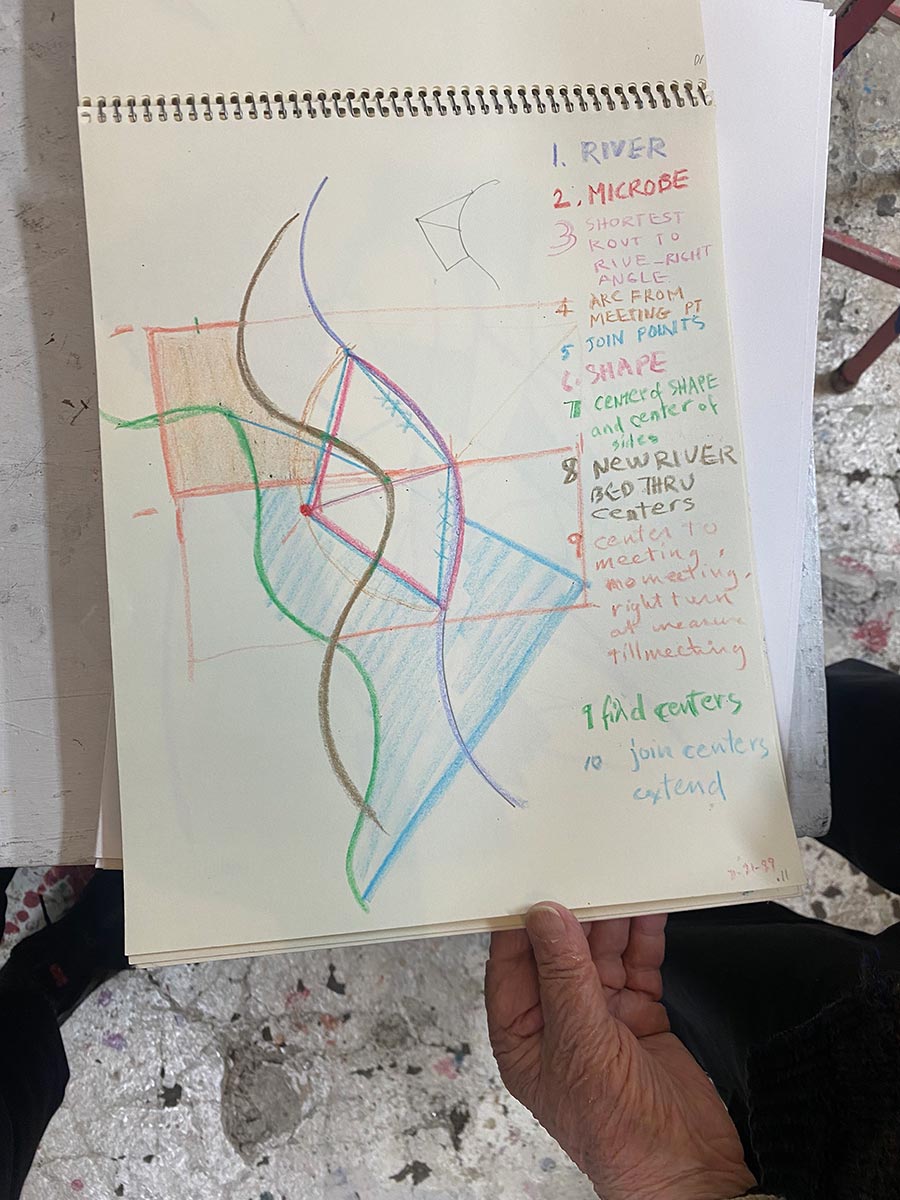‘Natasha’ as Code, or Future Friends Passing through the Digital Gate
In 1987, my uncle gifted us a computer. It was a product that was built by Yamaha in Japan, but as an Arabic-language technology that was conceived in 1983 in Kuwait. MSX Sakhr AX150 was a personal computer that operated in an Arabic interface and offered an array of software to engage with. We called it only Sakhr, an Arabic word that means rock but is also a common male name. At the time, we could not imagine an alternative to Sakhr’s limited color range and graphics possibilities. We spent hours on Sakhr trying every feature in its system and cartridges, until we eventually mastered booting its system, navigated it using tips from its manual, and learned how to mimic its operating sounds.
In 1986, Samia Halaby passed through a similar (digital) gate; her personal computer’s name was Amiga, a Spanish word that means female friend. After seeing an Apple II in her mathematician sister’s house in 1983 – and successfully trying to use Logo, a software that can relay instructions to a digital turtle to move a certain number of steps in different directions, eventually drawing a line as it travels – Samia shopped for her computer in New York. Samia read about the different computers on sale, visited computer shops, asked sales persons for details and information that were not necessarily known to them, and studied carefully the computers’ promotional videos. She finally bought an Amiga 1000 for 1000 USD, attracted to its system that offered much more color options than the other models. The artist began programming her art on this computer using Basic and C, studying these coding languages from manuals which sit until today in her library.
With Amiga, Samia delved deeper into a world of art-making. As an abstract painter, she questioned the medium versus the knowledge she had amassed until that moment. She learned that she did not want to reproduce digital versions of her own paintings, but to find ways of “expanding the language of picture making.” 1 She writes, “there would be no point in using the computer medium to create paintings if they could be done in pigments.” A computer-generated art piece should not be a “primitive static image.” It should allow a painting to be what a canvas could not offer, while pushing the limits of the artist’s/painter’s imagination beyond the acquired/established knowledge of her own medium. “A large swish of yellow over dark areas was a pleasurable novelty unique to the computer,” she notes. Shapes that shift in color and size – and often make their own noise – was the “kinetic abstraction” Samia sought.
Understand the careful attention of our eyes as we cross a street, or how our brain could bring a distant thing close through its sound. Kinetic abstraction was this ability to move with and around the elements of a painting, just like we navigate the endless possibilities of existence. If an end command is not written in its generating code, the painting will go on and on in Samia’s work: “I would press the key for the rain function to begin and rain fell all over the screen, I would then, using other keys, add larger shapes, one by one, that would then begin to accumulate ‘rain.’ The resulting screen was a group of shapes with varying degrees of accumulation. If no more shapes were added, the continuous rain would blur and make all shapes disappear.”
Niihau (1987) is a work named after an island in Hawaii, where Samia guest-taught before she returned to acquire her Amiga. A recording of the work, made in the same year, is two minutes and eight seconds. It shows a light violet 4:3 canvas with the word “Niihau” in its upper left corner. Computer-generated sounds precede the visuals, which start as five interlacing oval shapes in different colors that start to override other shapes and each other. After few minutes, the screen becomes populated with a dense mesh of shapes and colors. It is short, but the journey was so full of details that the memory of its beginning might have faded already, requiring that we watch it again. These works are stored as versions of series of codes, stored and indexed on 3½-inch floppy disks. The artist had carried them to exhibitions and performances on her bulky computer device, but for Natasha, we are showing them recorded or captured offscreen.

Fig. 2: Samia Halaby showing her work on Amiga during a studio visit by Ala Younis, New York, 4 April 2022 (Photo by the author).
When I visited Samia’s studio in New York, where she has lived since 1976, she demonstrated on her Amiga how she wrote and plays the work. She feeds her desktop computer with floppy disks, one for the booting system, then another for some of her works that exist in versions, similar to how we save several word files for the same text, each with a little addition or omission. She types commands into the system, and this shows directories of folders and their content [Fig. 1]. She then types the name of the work (which is a progam) that she wants to play, and it blows up into a full screen and presents one shape/sound after another [Fig. 2]. She cannot interrupt the work/program unless she cuts off the electrical supply. As we try to make a decision on how to show this work in Natasha, we also understand that the artwork is the code and not a particular manifestation that Samia has recorded in any stage of time. The work comes on screen clear and pristine, and I ask myself: Can a digital art from 1987 show a sign of its age? Does it have to?

Fig. 3: Samia Halaby showing her sketches during a studio visit by Ala Younis, New York, 4 April 2022 (Photo by the author).
In this studio visit, I told Samia about the name of the Singapore Biennale edition that we were inviting her to participate in. Natasha, I said. Samia contained a smile. I explained how we are using a biennial format to rethink the interrupted givens of our professional and personal lives, and how we are trying to articulate our thoughts through close and intimate conversations with artists that inspire us with their intimate involvement and blurred boundaries between their life and work. Samia’s smile grew bigger, and she disappeared shortly to return with sketch books [Fig. 3]. Fascinating drawings that she made before and after her computer works, which codify the meanings of the lines and shapes we see in her digital works.
In these sketches, a purple line is a river, a red dot is a microbe, a pink arch is the shortest route to the river, and an orange arc is a house for meeting. These entangled worlds of Samia are abilities to capture with the mind, before our eyes and devices, a logic of commands that instructs (a computer to convey) a journey. Here, Natasha is a code, Amiga, or Sakhr – a digital gate passed through in 1987 – a set of energies, an intention of companionship, an institution of the mind that, sometimes, can be mediated through physical, technological, or cerebral abilities.
Ala Younis is an artist, co-founder of the publishing initiative Kayfa ta, co-Head of Berlinale’s Forum Expanded, and research scholar at al Mawrid Arab Center for the Study of Art at NYU Abu Dhabi. E-mail: alayounis@gmail.com